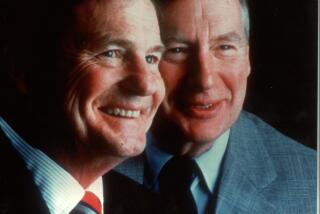THE PBS SERIES THAT WATCHES THE ANIMAL KINGDOM WITH STYLE
- Share via
Don’t come looking for “Wild Kingdom’s” Marlin Perkins. There’s nary a safari jacket or insurance ad in sight.
And don’t expect those Disney “True-Life Adventures” from the 1950s, which seemed bent on humanizing the wild kingdom, like editing footage of scorpions and setting it to music so they seemed to be square-dancing.
No, “Eyewitness” is a nature show for the ‘90s.
While this weekly PBS series seldom loses sight of its primary mission--illuminating the world of animals--it does the job in a high-tech way that should even catch the eye of naturephobes.
Sure, “Eyewitness,” airing Monday nights on PBS stations, gets a little carried away calling itself “an entirely new concept in television.”
But its production values are unquestionably state-of-the-art. Homing in on its topic--usually a particular animal--a half-hour “Eyewitness” segment blends live-action sequences and graphic images with macro- and micro-photography, animation, and computer “morphing” to do what television does best: isolate and zero in.
The series employs what its producers call “the technology of white,” which is a fancy way of saying things of interest are lifted from their usual surroundings, then placed, in combination with other things, against a background of pure white.
With visuals and accompanying words, “Eyewitness” becomes a dynamic fusion of biology, mythology, history and fantasy. Although a bit uneven in its first five weeks, the series, at its best, is a pretty neat trip for all ages.
A recent “Eyewitness” about birds certainly took flight. Not only informative, it was an excellent example of the video razzmatazz that sets this series apart.
As it does every week, “Eyewitness” starts with a dazzling magical flight through the Eyewitness Museum, a computer-generated, multilayered hall of wonders filled with galleries and exhibits. This becomes viewers’ virtual home base as the rest of the program carries them in and out of pertinent imagery, making narrative connections along the way.
The program about the birds abounded with fun facts, among them:
* The ostrich is the world’s heaviest animal at 260 pounds, hence flightless. Yet it’s able to run at 40 mph, making it the fastest animal on two legs.
* Ravens once were believed able to report news from far away, which gave rise to the expression “a little bird told me.”
* The association of the egg with rebirth persists in the Christian celebration of Easter, with the Easter egg symbolizing Christ’s tomb from which he was resurrected.
* While a human’s resting heart rate is 60 beats per minute, a robin’s heart beats at 600 times per minute.
With its stylized approach, perhaps “Eyewitness” does denature nature a bit. And some may dismiss it as “McLearning,” whether they’re referring to McDonald’s or an Apple Macintosh.
Even so, as an eye-opening crash course, “Eyewitness” is a natural.
This week, look for “Elephant.” And after that, there’s “Shark,” “Insect,” “Amphibian,” “Dinosaur,” “Jungle,” and, on June 26, one of the coolest of all, “Skeleton,” for the series’ conclusion.
Not scheduled to air, though it should, is “The Making of Eyewitness,” which sheds light on the remarkable labors and expense (a half-million dollars per segment) behind this series.
“Eyewitness” is a co-production of BBC Lionheart Television, Dorling Kindersley Vision and PBS, in association with Oregon Public Broadcasting. It’s inspired by Dorling Kindersley books, the London publisher of children’s and family reference books.
Already, another batch of 13 “Eyewitness” segments is in production. That’s good news.
And it’s a good chance to fix the program’s one major flaw: Martin Sheen as narrator. His voice is far too routine for a series this distinctive.
Maybe the producers could try to win over a vocal PBS opponent by bringing on Newt Gingrich to narrate the show. After all, he’s Speaker of the House.
More to Read
The complete guide to home viewing
Get Screen Gab for everything about the TV shows and streaming movies everyone’s talking about.
You may occasionally receive promotional content from the Los Angeles Times.






